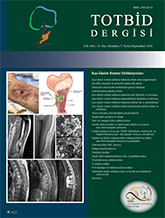
Diagnosis and treatment of musculoskeletal infections are difficult due to their pathophysiological features. There are various radiological and radionuclide imaging methods used in diagnosis. However, all tests have their own limitations. The imaging methods used differ between centers according to local experience, techniques availability and costs. Nuclear medicine methods allow detection of infection and inflammatory foci with functional and metabolic mechanisms before anatomical changes occur. Three-phase bone scintigraphy is one of the most widely used nuclear medicine methods in musculoskeletal infections due to its easy accessibility, cheapness and high sensitivity. Gallium-67 scintigraphy is used only to diagnose spondylodiscitis in today`s practice. Labeled leukocyte scintigraphy remains the most valuable imaging modality in musculoskeletal infections except vertebral infections. Diagnostic accuracy is expected to increase thanks to the widespread use of standardized imaging and evaluation protocols which are included in the guidelines in recent years. Complementary bone marrow scintigraphy may be required in suspicious cases. Although accuracy ratios were obtained similar to leukocyte scintigraphy labeled with antigranulocyte monoclonal antibody or antibody fragments, they also have their own limitations. Adding SPECT/CT to the planar images increases the sensitivity and specificity of the scintigraphic methods. The value of FDG PET and FDG PET/CT in the diagnosis of musculoskeletal infections has been investigated in recent years and continues to be investigated. Although the role of FDG PET in other areas is still controversial, its net benefit in spinal osteomyelitis has been recognized. The recently introduced PET/MRI is expected to overcome the shortcomings of all other methods by combining excellent anatomical and soft tissue imaging capacity and molecular PET knowledge.